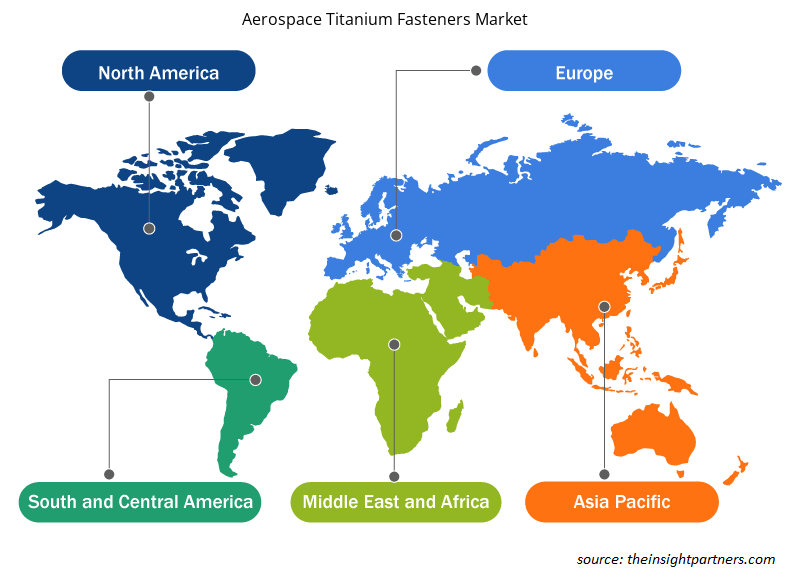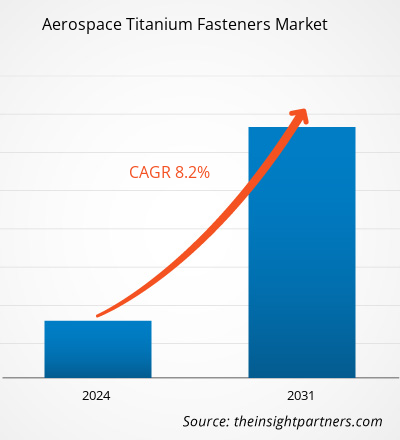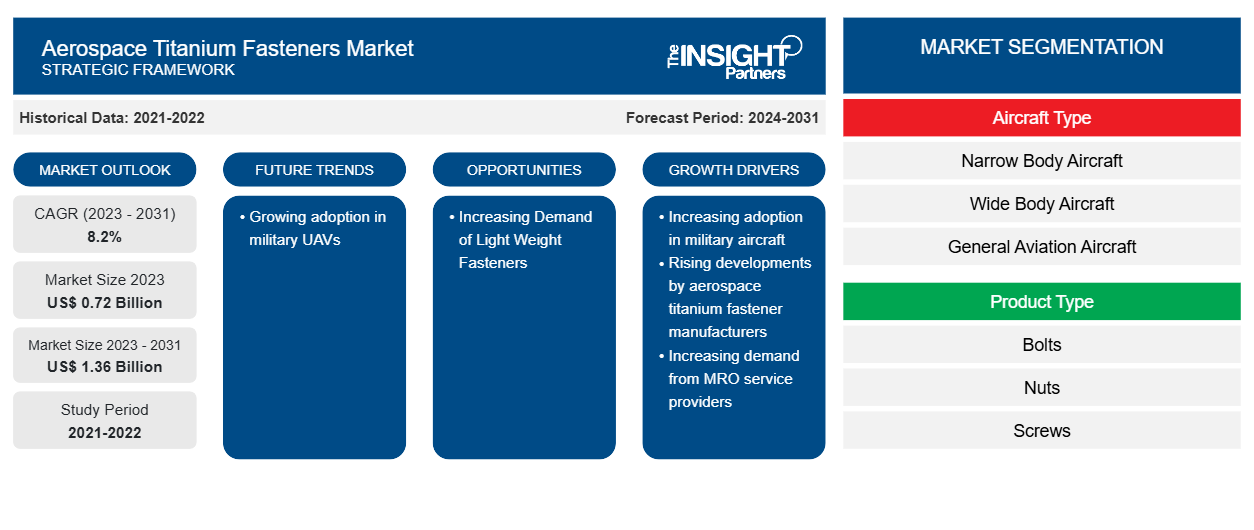Le marché des fixations en titane pour l'aéronautique devrait atteindre 1,36 milliard USD d'ici 2031, contre 0,72 milliard USD en 2023. Le marché devrait enregistrer un TCAC de 8,2 % au cours de la période 2023-2031. L'adoption croissante des drones militaires devrait rester une tendance clé du marché.
Analyse du marché des fixations en titane pour l'aéronautique
Parmi les principaux acteurs opérant sur le marché mondial des fixations en titane pour l'aéronautique figurent LISI Aerospace, Apollo Aerospace Components Limited, Howmet Aerospace Inc, KLX Inc et 3V Fasteners. Le marché est fragmenté et compte un grand nombre d'acteurs répondant à la demande nationale et internationale. Les entreprises répondent en permanence à la demande générée par leurs flottes régionales respectives, ce qui stimule encore davantage la croissance des fixations en titane dans l'industrie aéronautique.
Aperçu du marché des fixations en titane pour l'aéronautique
L'écosystème du marché des fixations en titane pour l'aéronautique est diversifié et en constante évolution. Ses parties prenantes sont les fournisseurs de matières premières, les fabricants de fixations en titane pour l'aéronautique et les utilisateurs finaux. Les principaux acteurs occupent des places dans divers nœuds de l'écosystème du marché. Les fournisseurs de matières premières fournissent des matériaux aux fabricants de fixations, qui les utilisent ensuite pour fabriquer et concevoir les produits finis. Le produit final est ensuite fourni aux constructeurs d'avions, aux fabricants de composants et aux fournisseurs de MRO par différents moyens, tels que les ventes directes par l'intermédiaire de distributeurs d'entreprise ou les ventes à des tiers par l'intermédiaire de distributeurs tiers. Les OEM ou les fabricants de composants d'aéronefs intègrent ensuite les produits de fixation à leurs produits d'assemblage respectifs.
Personnalisez ce rapport en fonction de vos besoins
Vous bénéficierez d'une personnalisation gratuite de n'importe quel rapport, y compris de certaines parties de ce rapport, d'une analyse au niveau des pays, d'un pack de données Excel, ainsi que de superbes offres et réductions pour les start-ups et les universités.
-
Obtenez les principales tendances clés du marché de ce rapport.Cet échantillon GRATUIT comprendra une analyse de données, allant des tendances du marché aux estimations et prévisions.
Facteurs moteurs et opportunités du marché des fixations en titane pour l'industrie aérospatiale
Demande croissante de la part des prestataires de services MRO
Les opérations de maintenance, de réparation et de révision (MRO) consistent en une inspection périodique, une rectification des défauts, une révision, un remplacement et la réalisation de modifications d'aéronefs pour la navigabilité continue d'un aéronef et de ses pièces. Les aéronefs sont périodiquement entretenus pour aider à remplacer et à réparer diverses pièces aérospatiales, telles que le train d'atterrissage et le moteur, pour un fonctionnement optimal de l'aéronef. Ainsi, l'augmentation des dépenses MRO pour les avions militaires et commerciaux stimule par la suite la croissance du marché des fixations en titane pour l'aéronautique. Par exemple, en mars 2021, Sichuan Airlines a attribué un contrat de services MRO de cinq ans à MTU Maintenance pour ses avions A319, A320 et A321. En avril 2021, IndiGo Airlines a prolongé son contrat MRO avec Air France Industries KLM Engineering & Maintenance pour sa flotte d'A320. De plus, d'autres développements au cours des années 2022 et 2023 liés aux activités MRO sous contrat dans différentes régions ont stimulé le marché des fixations aérospatiales dans différentes régions dans le passé. En outre, la croissance du secteur MRO aéronautique est un autre facteur majeur susceptible de stimuler le marché des fixations en titane pour l’aéronautique dans les années à venir également.
Demande croissante de fixations légères
Les acteurs mondiaux de l'industrie aéronautique mettent l'accent sur la fabrication, l'intégration ou le montage de matériaux légers sur les modèles d'avion. Les autorités aéronautiques, les constructeurs d'avions, les fabricants de composants d'avions, les prestataires de services MRO et les forces militaires recherchent des matériaux légers pour chaque composant afin d'étendre l'autonomie de vol de l'avion et d'augmenter le rendement énergétique. L'alliage de titane est devenu un matériau structurel essentiel pour l'aviation civile , car les fabricants d'avions civils avancés l'utilisent largement. En outre, il existe actuellement de nombreuses applications des fixations en titane dans la production d'un avion. Par exemple, les applications des fixations en titane dans un avion comprennent les trains d'atterrissage, les moteurs à réaction, les pales de ventilateur, les ailes, les hélices, la cellule et différents types d'arbres. En outre, les livraisons futures attendues d'environ 40 000 unités d'avions commerciaux d'ici la fin de 2042 devraient également générer de nouvelles opportunités pour les fournisseurs du marché dans les années à venir.
Analyse de segmentation du rapport sur le marché des fixations en titane pour l'aéronautique
Les segments clés qui ont contribué à l’élaboration de l’analyse du marché des fixations en titane pour l’aérospatiale sont le type d’avion, le type de produit, l’application et l’utilisateur final.
- En fonction du type d'avion, le marché est segmenté en avions à fuselage étroit, avions à fuselage large, avions d'aviation générale, avions cargo, hélicoptères et avions militaires. Le segment des avions à fuselage étroit détenait une part de marché plus importante en 2023.
- En fonction du type de produit, le marché est segmenté en boulons, écrous, vis, rivets et autres. Le segment des boulons détenait une part de marché plus importante en 2023.
- En fonction des applications, le marché est segmenté en surfaces de contrôle de vol, cellules, moteurs, intérieurs et trains d'atterrissage. Le segment des cellules détenait une part de marché plus importante en 2023.
- En fonction de l'utilisateur final, le marché est segmenté en constructeurs aéronautiques, prestataires de services MRO et forces militaires. Le segment des constructeurs aéronautiques détenait une part de marché plus importante en 2023.
Analyse des parts de marché des fixations en titane pour l'aéronautique par zone géographique
La portée géographique du rapport sur le marché des fixations en titane pour l'aérospatiale est principalement divisée en cinq régions : Amérique du Nord, Europe, Asie-Pacifique, Moyen-Orient et Afrique et Amérique du Sud.
Français L'Amérique du Nord a dominé le marché en 2023, suivie de l'Europe et de la région Asie-Pacifique. En outre, l'Asie-Pacifique devrait également connaître le TCAC le plus élevé dans les années à venir. Les États-Unis ont dominé le marché nord-américain des fixations en titane pour l'aéronautique en 2023. Les États-Unis possèdent la plus grande industrie aérospatiale au monde. Selon les statistiques de la Federal Aviation Administration (FAA), entre 2022 et 2043, le nombre d'avions de la flotte des principaux transporteurs américains devrait passer de 3 915 à 5 925, en raison de la croissance du transport aérien. Certains des plus grands constructeurs d'avions au monde, à savoir Boeing, Lockheed Martin, Textron, Gulfstream et Airbus, ont leurs bases de fabrication établies aux États-Unis. De plus, les fixations et autres composants d'aéronefs sont susceptibles d'être très demandés en raison d'une augmentation des commandes d'avions commerciaux et d'affaires, ce qui conduit à terme à stimuler le marché des fixations en titane pour l'aéronautique.
Aperçu régional du marché des fixations en titane pour l'aéronautique
Les tendances et facteurs régionaux influençant le marché des fixations en titane pour l’aéronautique tout au long de la période de prévision ont été expliqués en détail par les analystes d’Insight Partners. Cette section traite également des segments et de la géographie du marché des fixations en titane pour l’aéronautique en Amérique du Nord, en Europe, en Asie-Pacifique, au Moyen-Orient et en Afrique, ainsi qu’en Amérique du Sud et en Amérique centrale.

- Obtenez les données régionales spécifiques au marché des fixations en titane pour l'aérospatiale
Portée du rapport sur le marché des fixations en titane pour l'aérospatiale
| Attribut de rapport | Détails |
|---|---|
| Taille du marché en 2023 | 0,72 milliard de dollars américains |
| Taille du marché d'ici 2031 | 1,36 milliard de dollars américains |
| Taux de croissance annuel composé mondial (2023-2031) | 8,2% |
| Données historiques | 2021-2022 |
| Période de prévision | 2024-2031 |
| Segments couverts |
Par type d'avion
|
| Régions et pays couverts |
Amérique du Nord
|
| Leaders du marché et profils d'entreprises clés |
|
Densité des acteurs du marché des fixations en titane pour l'aéronautique : comprendre son impact sur la dynamique commerciale
Le marché des fixations en titane pour l'aéronautique connaît une croissance rapide, tirée par la demande croissante des utilisateurs finaux en raison de facteurs tels que l'évolution des préférences des consommateurs, les avancées technologiques et une plus grande sensibilisation aux avantages du produit. À mesure que la demande augmente, les entreprises élargissent leurs offres, innovent pour répondre aux besoins des consommateurs et capitalisent sur les tendances émergentes, ce qui alimente davantage la croissance du marché.
La densité des acteurs du marché fait référence à la répartition des entreprises ou des sociétés opérant sur un marché ou un secteur particulier. Elle indique le nombre de concurrents (acteurs du marché) présents sur un marché donné par rapport à sa taille ou à sa valeur marchande totale.
Les principales entreprises opérant sur le marché des fixations en titane pour l'aérospatiale sont :
- Métaux XOT
- Leeart Industry Co., Ltd.
- B&B Spécialités Inc.
- Fixations 3V
- LISI Aérospatiale
- Cherry Aerospace
Avis de non-responsabilité : les sociétés répertoriées ci-dessus ne sont pas classées dans un ordre particulier.

- Obtenez un aperçu des principaux acteurs du marché des fixations en titane pour l'aéronautique
Actualités et développements récents du marché des fixations en titane pour l'aéronautique
Le marché des fixations en titane pour l'aéronautique est évalué en collectant des données qualitatives et quantitatives après des recherches primaires et secondaires, qui comprennent d'importantes publications d'entreprise, des données d'association et des bases de données. Quelques-uns des développements sur le marché des fixations en titane pour l'aéronautique sont répertoriés ci-dessous :
- MEIDOH Co., Ltd., un leader international dans la production de fixations automobiles, a le plaisir d'annoncer l'acquisition de Pilgrim Screw Corporation d/b/a Pilgrim Aerospace Fasteners (« Pilgrim »). (Source : MEIDOH Co Ltd, communiqué de presse, janvier 2024)
- TriMas (NASDAQ : TRS) a annoncé aujourd'hui que TriMas Aerospace a remporté des contrats pluriannuels avec Airbus de Toulouse, en France. Les activités Monogram Aerospace Fasteners et Allfast Fastening Systems de TriMas Aerospace ont toutes deux remporté de nouveaux contrats d'approvisionnement auprès d'Airbus, élargissant ainsi l'activité de vente de fixations techniques de la société en Europe. (Source : TriMas, communiqué de presse, février 2020)
Rapport sur le marché des fixations en titane pour l'aéronautique et l'espace
Le rapport « Taille et prévisions du marché des fixations en titane pour l’aéronautique (2021-2031) » fournit une analyse détaillée du marché couvrant les domaines ci-dessous :
- Taille et prévisions du marché des fixations en titane pour l'aéronautique aux niveaux mondial, régional et national pour tous les segments de marché clés couverts par le périmètre
- Tendances du marché des fixations en titane pour l'aéronautique ainsi que la dynamique du marché, telles que les facteurs moteurs, les contraintes et les opportunités clés
- Analyse détaillée des cinq forces du porteur
- Analyse du marché des fixations en titane pour l'aéronautique couvrant les principales tendances du marché, le cadre mondial et régional, les principaux acteurs, les réglementations et les développements récents du marché
- Analyse du paysage industriel et de la concurrence couvrant la concentration du marché, l'analyse de la carte thermique, les principaux acteurs et les développements récents pour le marché des fixations en titane pour l'aérospatiale
- Profils d'entreprise détaillés
- Analyse historique (2 ans), année de base, prévision (7 ans) avec TCAC
- Analyse PEST et SWOT
- Taille du marché Valeur / Volume - Mondial, Régional, Pays
- Industrie et paysage concurrentiel
- Ensemble de données Excel
Rapports récents
Témoignages
Raison d'acheter
- Prise de décision éclairée
- Compréhension de la dynamique du marché
- Analyse concurrentielle
- Connaissances clients
- Prévisions de marché
- Atténuation des risques
- Planification stratégique
- Justification des investissements
- Identification des marchés émergents
- Amélioration des stratégies marketing
- Amélioration de l'efficacité opérationnelle
- Alignement sur les tendances réglementaires























 Obtenez un échantillon gratuit pour - Marché des fixations en titane pour l'aérospatiale
Obtenez un échantillon gratuit pour - Marché des fixations en titane pour l'aérospatiale